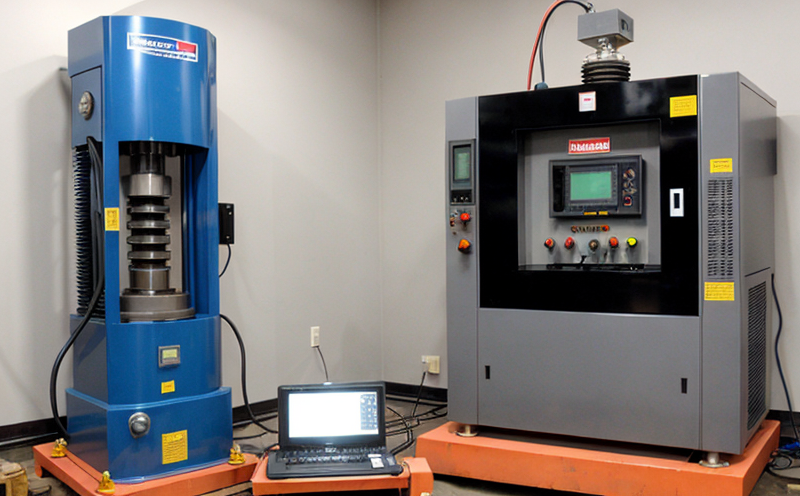JEDEC JESD22 B103 Vibration Testing for Semiconductor Devices
The JEDEC JESD 22B103 vibration test is a critical procedure used to evaluate the robustness of semiconductor devices under dynamic mechanical stress. This testing ensures that electronic components can withstand harsh environmental conditions, particularly those encountered during transport and installation. The primary goal of this test is to identify potential weaknesses in the design or manufacturing process which could lead to failure.
During a vibration test according to JESD22B103, semiconductor devices are subjected to controlled levels of random vibration along three axes (X, Y, Z). The frequency range typically spans from 10 Hz to 500 Hz. Specimens undergo rigorous testing at specific amplitude and duration levels prescribed by the standard. Compliance with these standards is essential for manufacturers aiming to meet quality expectations set forth by end-users.
The test setup includes a vibration table capable of generating precise frequency sweeps across multiple channels, ensuring accurate reproduction of real-world conditions experienced during shipment or use in demanding environments like automotive or aerospace industries. Engineers must adhere strictly to the prescribed parameters when conducting tests since any deviation could lead to incorrect results.
Preparation involves careful selection and assembly of samples according to JESD22B103 guidelines, followed by proper mounting onto a fixture suitable for the test setup. Pre-test inspections ensure that all components are in good working condition before being exposed to vibrations. Post-test analysis focuses on identifying any signs of damage or degradation due to mechanical forces acting upon them.
After completing the vibration test per JESD22B103, engineers analyze data collected from accelerometers placed within each device during testing. This information helps determine whether the unit has sustained unacceptable levels of stress. Acceptance criteria are defined based on pre-established thresholds for acceptable deviations from nominal values.
Compliance with this standard is crucial not only for meeting regulatory requirements but also for maintaining a high level of trust between manufacturers and customers. By ensuring that products pass stringent vibration tests like JESD22B103, companies demonstrate their commitment to producing reliable and durable electronic components.
In summary, the JESD22B103 test is an indispensable tool in quality assurance programs designed to enhance product reliability across various sectors. Its role cannot be overstated as it plays a vital part in safeguarding both consumer safety and brand reputation.
Why It Matters
Maintaining the integrity of electronic components during transportation and operation is paramount for industries reliant on advanced technology. The JESD22B103 vibration test serves as a critical quality control measure by simulating the effects of mechanical shock and vibration that these devices might encounter throughout their lifecycle.
- Ensures product reliability under harsh environmental conditions
- Promotes compliance with international standards
- Safeguards against potential failures during shipment or use
- Enhances brand reputation through consistent performance guarantees
The results of this testing provide valuable insights into the robustness and durability of semiconductor devices, allowing manufacturers to make informed decisions regarding design improvements. Compliance with JESD22B103 also facilitates smoother interaction between suppliers, integrators, and end-users by ensuring compatibility across different systems.
Applied Standards
| Standard | Description |
|---|---|
| JESD22B103 | Vibration Test Method for Semiconductor Devices |
| IEC 68-2-6 | Environmental Testing - Part 2: Tests and Requirements - Section 6: Vibration (Single Axis) |
The JESD22B103 standard specifies the procedure for performing vibration tests on semiconductor devices. It includes detailed instructions on test setup, specimen preparation, measurement techniques, and acceptance criteria.
Industry Applications
- Aerospace & Defense
- Automotive Electronics
- Medical Devices
- Telecommunications Equipment
| Application | Description |
|---|---|
| Aerospace & Defense | Vibration testing ensures reliability of components used in space and military applications. |
| Automotive Electronics | Evaluates the durability of electronic systems employed in vehicles subjected to constant vibration during operation. |
| Medical Devices | Guarantees safe handling of medical equipment exposed to varying levels of mechanical stress. |
| Telecommunications Equipment | Aids in assessing the resilience of network infrastructure against environmental challenges. |
Vibration testing according to JESD22B103 is particularly important for industries where product reliability under extreme conditions can mean life-or-death situations. By adhering to this standard, manufacturers ensure that their products meet stringent quality benchmarks necessary for these critical applications.





